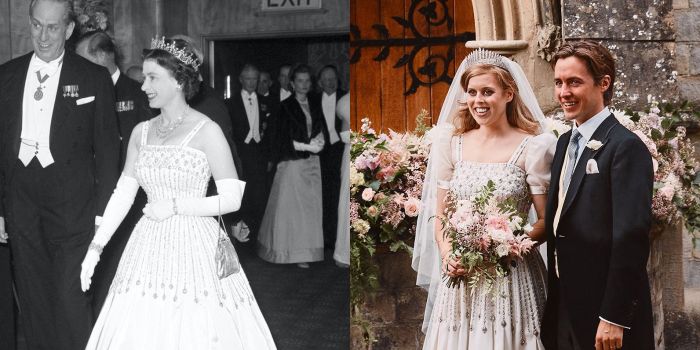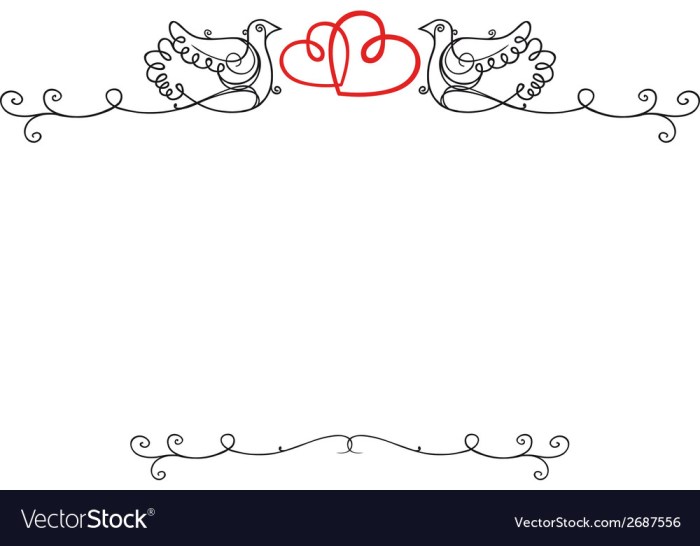Defining “Old Style” Wedding Dresses: Old Style Wedding Dresses
Old style wedding dresses – The term “old style” wedding dresses encompasses a broad range of styles spanning several decades, each reflecting the prevailing fashion and social norms of its time. Understanding the nuances of these different eras is key to appreciating the evolution of bridal fashion.
Different Eras of Old Style Wedding Dresses

Source: hearstapps.com
Several distinct eras contribute to the definition of “old style” wedding dresses. Each era possesses unique design elements that set it apart.
- Victorian Era (1837-1901): Characterized by full skirts, long trains, high necklines, and intricate detailing like lace, embroidery, and beading. Often featured a romantic, somewhat ethereal aesthetic. Silhouettes were typically bell-shaped or A-line.
- Edwardian Era (1901-1910): Saw a shift towards a more streamlined silhouette, with longer, narrower skirts and a more fitted bodice. Lace and delicate embellishments remained popular, but the overall look was more refined and elegant than the Victorian era.
- 1920s: The flapper era brought a dramatic change, with shorter hemlines, dropped waists, and looser, more comfortable silhouettes. Beading and embellishments were still prevalent, but the overall feel was more playful and modern.
- 1950s: This era is known for its full, cinched waists, and often featured petticoats to create a voluminous skirt. A-line and ballgown silhouettes were popular, with fabrics like satin and lace commonly used.
The comparison between these eras reveals a fascinating evolution. From the voluminous and romantic Victorian styles to the sleek and modern designs of the 1920s, and the full-skirted glamour of the 1950s, each era showcases a distinct approach to bridal fashion.
Fabric and Materials

Source: vectorstock.com
The choice of fabric significantly impacts the look, feel, and cost of an old-style wedding dress. Understanding the properties of these fabrics is crucial for appreciating their contribution to the overall aesthetic.
Common Fabrics in Old Style Wedding Dresses
Several fabrics have been consistently popular throughout the history of wedding dress design. Each offers unique properties that influence the final appearance and longevity of the garment.
- Silk: Known for its luxurious drape, sheen, and delicate texture. Various types of silk, such as charmeuse, satin, and organza, offer different levels of sheen and weight.
- Lace: A timeless embellishment, lace adds a touch of elegance and sophistication. Different lace types, such as Chantilly, Alençon, and Irish lace, offer unique patterns and textures.
- Satin: A smooth, lustrous fabric that drapes beautifully and creates a sleek silhouette. Its sheen adds a touch of glamour and sophistication.
- Tulle: A lightweight, sheer netting often used for underskirts or as a layer to add volume and texture.
The cost of these fabrics varies significantly, with silk and high-quality lace often being the most expensive options. Proper care and maintenance are essential to preserve the longevity and beauty of these delicate fabrics.
Silhouettes and Styles
The silhouette of a wedding dress has dramatically evolved throughout history, reflecting changing social norms and fashion trends. The following table illustrates the diverse silhouettes found in various eras.
Evolution of Wedding Dress Silhouettes, Old style wedding dresses
| Year | Silhouette | Common Fabrics | Notable Features |
|---|---|---|---|
| Victorian Era (1837-1901) | A-line, Bell-shaped | Silk, Lace, Muslin | Full skirts, long trains, high necklines, intricate embellishments |
| Edwardian Era (1901-1910) | Fitted bodice, long narrow skirt | Silk, Lace, Satin | More streamlined silhouette, delicate embellishments |
| 1920s | Dropped waist, loose fitting | Silk, Beaded fabrics, chiffon | Shorter hemlines, playful and modern |
| 1950s | A-line, Ballgown | Satin, Lace, Tulle | Full skirts, cinched waists, petticoats |
The evolution of the wedding dress neckline is equally fascinating. From the high, often closed necklines of the Victorian era, the neckline gradually lowered throughout the 20th century, reflecting changing societal attitudes towards modesty and female liberation.
Imagine a visual journey: high, often stiff necklines giving way to the softer, lower necklines of the Edwardian era; the plunging necklines and bare shoulders of the 1920s flapper dresses; and finally, the sweetheart necklines and off-the-shoulder styles of the 1950s, each style reflecting the changing sensibilities of the time. This visual evolution demonstrates a progression from formality to a more relaxed, expressive style.
Embellishments and Details
The embellishments on old-style wedding dresses played a significant role in conveying social status and cultural context. These details often reflected the craftsmanship and artistry of the era.
Common Embellishments on Old Style Wedding Dresses
Various embellishments were used to enhance the beauty and elegance of old-style wedding dresses. The techniques used to create these embellishments also evolved over time.
Okay, so like, grandma’s wedding pics? Total vintage vibes with those old-style wedding dresses, right? But if you’re a guest and need something a bit more modern, check out these short sleeve dresses for wedding guests – they’re super chic. Still, nothing beats the timeless elegance of those old-school gowns, though!
- Lace: Hand-made lace, particularly in the Victorian and Edwardian eras, was a symbol of wealth and status, demonstrating the time and skill involved in its creation.
- Beading: Intricate beading, often found in the 1920s and later, added sparkle and glamour, reflecting the Art Deco influence of the period.
- Embroidery: Hand-embroidered details, often floral motifs, added a touch of artistry and personalization.
- Pearls: Pearls symbolized purity and elegance, and their use in wedding dresses increased in popularity over time.
The significance of these embellishments varied across different eras and social classes. Intricate hand-crafted embellishments were often a marker of wealth and status, while simpler embellishments were more accessible to brides of more modest means.
Modern Interpretations of Old Style Wedding Dresses
Contemporary designers frequently draw inspiration from old-style wedding dresses, incorporating elements of past eras into modern designs. This blending of old and new creates unique and appealing styles for modern brides.
Modern Interpretations of Old Style Wedding Dresses
Modern designers often take key elements—such as the lace detailing of a Victorian gown or the silhouette of a 1950s dress—and adapt them to create contemporary looks. For instance, a modern gown might feature a high neckline reminiscent of the Victorian era, but with a sleek, fitted silhouette and modern fabric choices. Similarly, a 1920s-inspired dress might incorporate the dropped waist and embellishments of that era but with a more streamlined and comfortable fit.
The appeal lies in the blend of classic elegance and modern comfort.
Compared to the often restrictive and less practical old-style dresses, modern interpretations prioritize comfort and ease of movement. While maintaining the elegance and aesthetic appeal of vintage designs, modern adaptations incorporate stretch fabrics, more forgiving silhouettes, and simpler closures, making them more suitable for the modern bride’s active lifestyle. Old-style dresses, while beautiful, could be restrictive and difficult to move in, requiring significant upkeep.
Modern interpretations successfully bridge the gap between timeless style and modern practicality.
Finding and Preserving Old Style Wedding Dresses
Finding and preserving an old-style wedding dress requires careful consideration and research. Authenticating and caring for these delicate garments is crucial to ensure their longevity.
Sources and Preservation of Old Style Wedding Dresses
Several avenues exist for discovering vintage or antique wedding dresses, each requiring a different approach to authentication and preservation.
- Antique shops and vintage boutiques: These offer a chance to examine dresses in person, allowing for a thorough assessment of their condition and authenticity.
- Online marketplaces: Websites like eBay and Etsy provide a vast selection, but require careful vetting of sellers and a thorough examination of photos and descriptions.
- Estate sales and auctions: These can yield unique finds, but often require more research and a willingness to compete for items.
Authenticating a vintage dress involves examining its construction, fabrics, and embellishments to determine its age and origin. Expert appraisal may be necessary for particularly valuable or delicate pieces. Preservation involves careful cleaning, storage, and handling to prevent damage.
Caring for and Storing a Vintage Wedding Dress
Proper care and storage are essential for preserving a vintage wedding dress. The following steps ensure its longevity:
- Professional Cleaning: Have the dress professionally cleaned by a specialist experienced in handling delicate vintage fabrics.
- Acid-Free Storage: Store the dress in an acid-free box or garment bag to prevent discoloration and deterioration.
- Cool, Dry Environment: Keep the dress in a cool, dry place away from direct sunlight and humidity.
- Regular Inspection: Periodically inspect the dress for any signs of damage or deterioration.
- Avoid Pressing: Avoid pressing the dress unless absolutely necessary, as heat can damage delicate fabrics.
Q&A
How can I tell if a vintage wedding dress is authentic?
Look for hallmarks like hand-stitching, high-quality materials (like real silk or lace), and unique construction details not found in mass-produced garments. A reputable vintage dealer can also help authenticate a dress.
How much do old-style wedding dresses typically cost?
Prices vary wildly depending on the age, condition, designer (if any), and materials. Expect to pay anywhere from a few hundred to several thousand dollars, or even more for truly exceptional pieces.
Where can I find a vintage wedding dress for sale?
Check out online marketplaces like Etsy, eBay, and specialized vintage clothing websites. Antique shops, consignment stores, and even some bridal boutiques carry vintage or vintage-inspired gowns.
How do I clean and preserve a vintage wedding dress?
Always consult a professional conservator or dry cleaner specializing in vintage textiles. Improper cleaning can severely damage delicate fabrics and embellishments.
